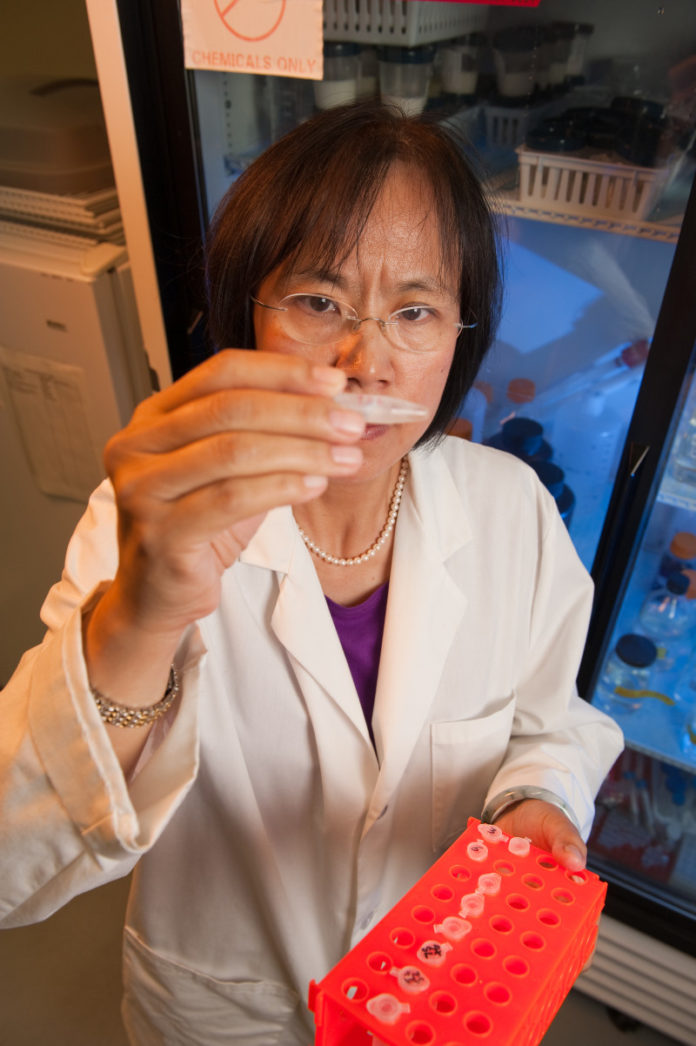
A novel jelly-like substance developed by Kansas State University researchers was recently issued a U.S. patent. The substance may be used for biomedical applications, ranging from cell culture and drug delivery to repairing and replacing tissue, organs and cartilage.
U.S. Patent No. 8,835,395, “Novel Protein Peptide Hydrogels,” was awarded to the Kansas State University Research Foundation, a nonprofit corporation responsible for managing technology transfer activities at the university.
The patent is licensed by the research foundation to the company PepGel LLC, started by the inventors to explore commercialization opportunities in biomedical research and medical device areas.
The patent is for research conducted by Xiuzhi “Susan” Sun, university distinguished professor of grain science and bio- and agro-engineering, and Hongzhou “John” Huang, a 2012 doctoral graduate. It covers various combinations of short peptides — compounds created from amino acids — that can be used to form hydrogels.
A hydrogel is a substance that can transform from a jelly-like state to a liquid-like state. Physically, the hydrogel looks similar to a blob of jelly, although it is less dense because it is composed of nearly 100 percent water.
“When the hydrogel is made, it has a jelly or tofu consistency, but colorless and transparent,” Sun said. “But when it is shaken, the gel can become like water and then return to its original state. When we first made it, we had never expected such phenomena and we thought we were onto something interesting.”
The hydrogel was created as a spinoff of a separate project — a protein-based glue that can be used in outer space and other extremely dry environments that Sun developed with Kansas State University’s John Tomich, professor of biochemistry. Sun decided to study a fraction of the peptide sequence that gave the glue its adhesive ability by attaching a heterogeneous hydrophilic peptide segment inspired by spider silk proteins.
The newly discovered peptide was formed with 19 amino acids and can self-assemble into 3-D nanofiber networks. These transform into a hydrogel by changing the pH level or introducing an ion, such as a calcium ion.
The nanofiber size and pore size of the hydrogel are in the similar range of a natural extracellular matrix in the biological system. Moreover, the hydrogel was found to have sheer-thinning and self-healing properties — meaning it could change from a gel to a liquid state and back to a gel again.
In addition to being able to rapidly change forms, the hydrogel formulas created by Sun and Huang are resistant to high temperatures up to 80-degrees Celsius at a neutral pH level.
“This hydrogel system has large variations and flexibility in controlling the gel stiffness, viscoelastic behavior and surface properties,” Sun said. “Because of this, the hydrogels may have numerous biomedical research uses and medical device application, including use as scaffolds or artificial extracellular matrix for tissue engineering and healing wounds; cell therapies; combining with stem cells to repair or replace organs; drug delivery; an adjuvant for vaccines; and drug and cell encapsulation.”
Sun is currently conducting collaborative research with hydrogels for applications and efficiency with anticancer drugs screening and delivery, stem cells and wound healing, as well as being used in vaccines for H1N1 influenza and animal diseases, such as the porcine reproductive and respiratory syndrome virus, or PRRS.
This hydrogel patent, along with several other patent pending applications, are licensed by the startup company PepGel LLC, which was co-founded by Sun and Huang to make their technology available for research use and medical device applications.
“We are pleased with the international interest in our hydrogel formulas and hope the hydrogels help develop meaningful medical applications that improve wellness, especially in areas such as cancer therapies,” said Tim Fealey, CEO of PepGel LLC.
Currently, the Kansas State University Research Foundation has been awarded eight U.S. patents in 2014 for inventions by Kansas State University researchers.
Story Source:
The above story is based on materials provided by Kansas State University. The original article was written by Greg Tammen. Note: Materials may be edited for content and length.
